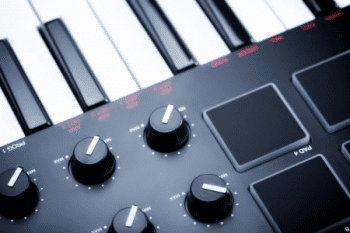How to Record Synthesizer in Three Ways

Recently analog synthesizers have made somewhat of a comeback as producers and composers have found digital samples, when compared side by side, to be lacking in warmth and range.
The upcoming documentary “[I Dream of Wires](http://www.idreamofwires.org/" rel="noopener noreferrerj "I Dream of Wires - Documentary")” covers how this trend toward analog sound synthesizing isn’t going away anytime soon.
As a result we thought it’d be helpful to share the three most common ways to record an analog synth. And, of course, a better recording makes for a [better mix](http://www.sageaudio.com/blog/pre-mastering-tips/home-recording-academy-getting-it-right-at-the-source.php" rel="noopener noreferrerj "Home Recording Academy: Getting it Right at the Source")and mastered song.
Record Directly Into Your Interface
Most synthesizers have a stereo output, often two quarter inch plugs. If your A/D interface has two inputs, the simplest way to record would be to plug your synth up directly using the line or instrument inputs. Adjust the volume on your synth to an optimal level (usually 80-100%) and hit record.
This way is best if you really want a clean, pure recording of your original synth sound. Though you may not get a sound as big and full as one from a preamp, having less steps on your signal flow will mean less noise and distortion in your final mix.
Record Through a Preamp
If you want to add some general warmth and presence to your sound try plugging your synth’s output into an analog preamp. Many engineers swear by this method as it can make an already great synth sound fantastic.
Of course, each preamp will add its own flavor to the sound, so be sure to play with it in order to get what you’re looking for. Rupert Neve preamps are well-liked for the classic analog sound and rich high’s. Or for a deeper bass, an API 512c might be a good place to start.
Using a preamp can be the best way to get that full synth sound you may be looking for. However, it can also cause your recording to lose a bit of fidelity and clarity, depending on the type and quality of the preamp you use.
Record Through A Guitar Amp
Finally, plugging your synth into a guitar amp can add some very nice color, depth and punch to your mix. You’ll want to then record your amp with a dynamic microphone, like a Shure SM57, and then run it into the mic input on your A/D interface. Though it seems like a shoddy way to mix your sound, a lot of producers love how synths sound through guitar amps and swear by this method.
Recording this way is probably the best technique for getting a fat vintage tone out of your synth. The amp will certainly add some grunge and depth to your mix, though, it will be at the cost of significant resolution.
With all of the tones and colors that synths are capable of producing, how you record them can also affect their sound in your mix. Don’t hesitate to experiment with these methods of recording until you find a sound you really like. As always, getting you want upfront will make mixing and mastering much better in the end.




